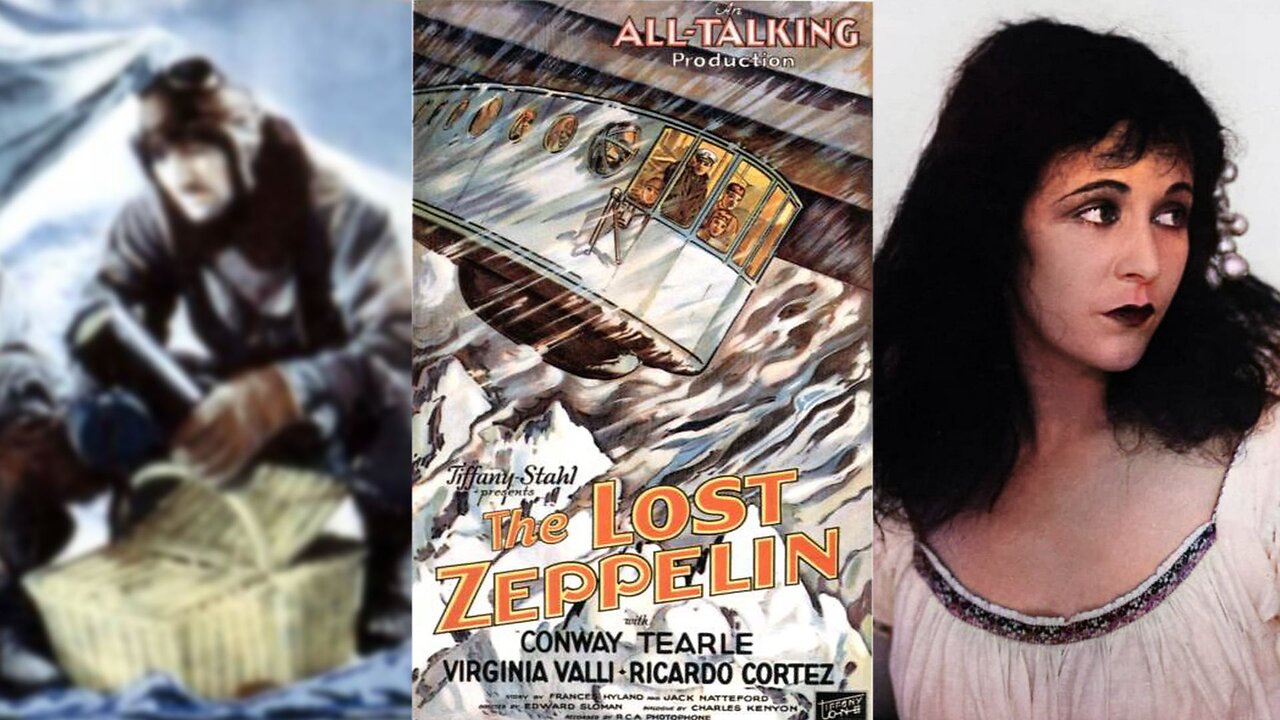Premium Only Content

THE LOST ZEPPELIN (1929) Conway Tearle, Virginia Valli & Ricardo Cortez | Adventure | B&W
The Lost Zeppelin is a 1929 sound adventure film directed by Edward Sloman and produced and distributed by Tiffany-Stahl. The film stars Conway Tearle, Virginia Valli and Ricardo Cortez.
Tearle plays a navy officer modeled on U. S. Navy Commander Richard Evelyn Byrd who was then a national aviation hero. Byrd made his own genuine Antarctic adventure With Byrd at the South Pole film during his South Pole Expedition 1928-1929.
SYNOPSIS
At a banquet preceding his flight to the South Pole, Commander Donald Hall (Conway Tearle), a Zeppelin commander in charge of the "Explorer", learns that his wife, Miriam (Virginia Valli), whom he worships, requests a divorce. She is in love with Lieutenant Tom Armstrong (Ricardo Cortez), his best friend and partner in the flight. Hall agrees to grant the divorce after the flight.
When the Zeppelin reaches the South Pole, a sudden gale causes it to crash and the men divide up into search parties. An aircraft with room for only one survivor leads to a decision by Hall that Armstrong should be the one to be saved.
CAST & CREW
Conway Tearle as Commander Donald Hall
Virginia Valli as Miriam Hall
Ricardo Cortez as Tom Armstrong
Duke Martin as Lieutenant Wallace
Kathryn McGuire as Nancy
Winter Hall as Mr. Wilson
Directed by Edward Sloman
Written by Jack Natteford (story) (as John Francis Natteford), Frances Hyland (adaptation), Charles Kenyon (dialogue)
Produced by Tiffany-Stahl
Cinematography Jackson Rose
Edited by Martin G. Cohn, W. Donn Hayes
Music by Meredith Willson
Production company Tiffany-Stahl Productions
Distributed by Tiffany Pictures
Release date December 20, 1929
Running time 8 reels
NOTES
The stagey early part of The Lost Zeppelin was dominated by a banquet scene and actors engaged in dialogue from static positions. The "shoddy production" values described by aviation film historian Michael Paris in From the Wright Brothers to Top gun: Aviation, Nationalism, and Popular Cinema (1995) were typical of the early sound film era.
The Zeppelin in The Lost Zeppelin is recreated in stock footage of flights, and the use of miniatures as well as a mockup of the gondola. Although technically, the special effects were satisfactory for the era, aviation film historian James H. Farmer in Celluloid Wings: The Impact of Movies on Aviation (1984) considered The Lost Zeppelin had "disappointing special effects and triangular plot."
Mordaunt Hall in his review for The New York Times gave a mostly negative review of The Lost Zeppelin, "Presumably the producers of "The Lost Zeppelin," an audible pictorial melodrama now at the Gaiety, do not believe in a very high order of intelligence among cinema audiences, for the best that can be said of the film is that it appears to have been fashioned with a view to appealing to boys from 8 to 10 years of age. Several such youngsters were at the first showing of this offering last Saturday afternoon, and they became volubly enthusiastic over the Antarctic blizzard, the far from impressive airship, the artificial ice fields and the clumsily designed chain of incidents."
The Lost Zeppelin is listed as "preserved" in the Library of Congress database.
-
 16:10
16:10
Lost n Found Films
28 minutes agoWOMAN TO WOMAN (1929) Podcast | Vintage Cenima
-
 LIVE
LIVE
Glenn Greenwald
3 hours agoLab Leak Revelations Prove Corrupt Suppression of COVID Dissent; CNN Boots Jim Acosta: Who & What is a "Journalist"? | SYSTEM UPDATE #398
5,799 watching -
 1:11:00
1:11:00
Donald Trump Jr.
7 hours agoFirst White House Press Briefing, Plus Behind the Scenes on Capitol Hill w/ Rep Vince Fong & Sen Eric Schmitt | TRIGGERED Ep.211
81.1K106 -
 1:45:52
1:45:52
Redacted News
4 hours agoBOMBSHELL! Trump about to announce largest spending FREEZE in American history, deep state in PANIC
109K192 -
 LIVE
LIVE
The StoneZONE with Roger Stone
1 hour agoTrump Authorizes ICE Raids That Save Women and Children | The StoneZONE w/ Roger Stone
722 watching -

Dr Disrespect
8 hours ago🔴LIVE - DR DISRESPECT - WARZONE - NEW SEASON 2 UPDATE
143K28 -
 58:55
58:55
Candace Show Podcast
4 hours agoBACKSTABBED: Justin Baldoni’s Leaked Voicemail, RFK Jr’s Betrayal | Candace Ep 140
97.1K162 -
 DVR
DVR
LFA TV
8 hours agoThe Deportation Mandate | TRUMPET DAILY 1.28.25 7pm
3.84K2 -
 LIVE
LIVE
The Big Mig™
11 hours agoFauci’s Fiction w/ Dr. Michael J Schwartz
2,428 watching -
 LIVE
LIVE
Edge of Wonder
3 hours agoChina’s DeepSeek AI Engineered to Censor, Control & Overpower USA
382 watching